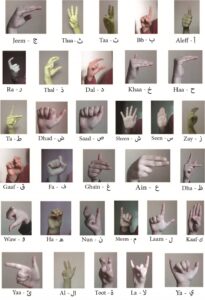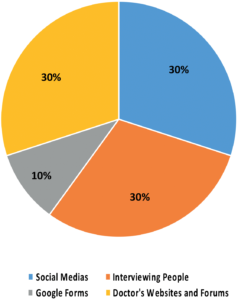2025
-Meriem Bounekdja, Soumia Kharfouchi, and Abdennour Boulesnane; and .
2025. "Analyzing and Classifying Coronary Artery Disease Severity Using Statistical Methods and Machine Learning Techniques" Statistics, Optimization & Information Computing
-Abdellah Zeggai, Ilyes Traikia, Abdelhak Lakehal, and Abdennour Boulesnane.
2025. "AI-VaxGuide: An Agentic RAG-Based LLM for Vaccination Decisions"
2024
-Abdennour Boulesnane and Abdelhakim Souilah.
2024. "An Evolutionary Large Language Model for Hallucination Mitigation" 1st International Conference on Electrical, Computer, Telecommunication and Energy Technologies (ECTE-Tech), Oum El Bouaghi, Algeria
-Abdennour Boulesnane, Lyna Bellil, and Maissoun Ghouzlen Ghiri; and .
2024. "A hybrid CNN-random forest model with landmark angles for real-time Arabic sign language recognition" Neural Computing and Applications
-Abdennour Boulesnane, Lyna Bellil, and Maissoun Ghouzlen Ghiri.
2024. "ASLAD-190K: Arabic Sign Language Alphabet Dataset
"
-Abdennour Boulesnane, Boutheina Mokhtari, Oumnia Rana Segueni, and Slimane Segueni.
2024. "Uterine Ultrasound Image Captioning Using Deep Learning Techniques". Proceedings of the 4th Tunisian-Algerian Joint Conference on Applied Computing (TACC 2024) Constantine, Algeria, December 17-18, 2024
-Lyna Bellil, Maissoun Ghouzlen Ghiri, and Abdennour Boulesnane.
2024. "Empowering Deaf Community in Healthcare Communication: 1D-CNN-Based Algerian Sign Language Recognition System," 2024 6th International Conference on Pattern Analysis and Intelligent Systems (PAIS), EL OUED, Algeria
-Abdennour Boulesnane. 2024. "Evolutionary Dynamic Optimization and Machine Learning". In: Valadi, J., Singh, K.P., Ojha, M., Siarry, P. (eds) Advanced Machine Learning with Evolutionary and Metaheuristic Techniques . Computational Intelligence Methods and Applications. Springer, Singapore.
2023
-Benmounah, Zakaria, Abdennour Boulesnane, Abdeladim Fadheli, and Mustapha Khial. 2023. "Sentiment Analysis on Algerian Dialect with Transformers" Applied Sciences 13, no. 20: 11157.
2022
-Abdennour Boulesnane, Souham Meshoul, and Khaoula Aouissi. 2022.
"Influenza-like Illness Detection from Arabic Facebook Posts Based on
Sentiment Analysis and 1D Convolutional Neural Network" Mathematics 10, no. 21: 4089.
-Abdennour Boulesnane, Yaakoub Saidi, Oussama Kamel, Mohammed Mounir Bouhamed and Rostom Mennour. DZchatbot: A Medical Assistant Chatbot in the Algerian Arabic Dialect using Seq2Seq Model. In 4th International Conference on Pattern Analysis and Intelligent Systems (PAIS 2022), 12-13 Oct 2022 Oum El Bouaghi, Algeria (2022)
-Abdennour Boulesnane and Souham Meshoul. Do We Need Change Detection for Dynamic Optimization Problems?: A Survey. In 2nd International Conference on Artificial Intelligence and Its Applications (AIAP 2021), 28-31 Jan 2022 ELOued, Algeria (2022).
2021
-Abdennour Boulesnane, Adel Beggag and Mustapha Zedadik, "A New Steganography Technique Based on Dotted Arabic Letters Features," 2021 International Conference on Networking and Advanced Systems (ICNAS), 2021, pp. 1-5, doi: 10.1109/ICNAS53565.2021.9628914.
https://doi.org/10.1109/ICNAS53565.2021.9628914
-Abdennour Boulesnane and Souham Meshoul. "Reinforcement Learning for Dynamic Optimization Problems." In 2021 Genetic and Evolutionary Computation Conference Companion (GECCO ’21 Companion), July 10–14, 2021, Lille, France. ACM, New York, NY, USA.
2018
-Abdennour Boulesnane and Souham Meshoul. "Effective Streaming Evolutionary Feature Selection Using Dynamic Optimization." IFIP International Conference on Computational Intelligence and Its Applications. Springer, Cham, 2018.
https://link.springer.com/chapter/10.1007%2F978-3-319-89743-1_29
2017
-Abdennour Boulesnane and Souham Meshoul. "WD2O: a novel wind driven dynamic optimization approach with effective change detection." Applied Intelligence 47.2 (2017): 488-504.
2015
-Abdennour Boulesnane and Souham Meshoul. "A modified wind driven optimization model for global continuous optimization." International Conference on Hybrid Artificial Intelligence Systems. Springer, Cham, 2015.
https://link.springer.com/chapter/10.1007/978-3-319-19644-2_25
2014
-Abdennour Boulesnane and Souham Meshoul. "A new multi-region modified wind driven optimization algorithm with collision avoidance for dynamic environments." International Conference in Swarm Intelligence. Springer, Cham, 2014.
https://link.springer.com/chapter/10.1007/978-3-319-11897-0_47
ASLAD-190K: Arabic Sign Language Alphabet Dataset consisting of 190,000 Images
The ASLAD-190K dataset is an extensive collection containing 190,000 meticulously labeled RGB images representing 32 alphabets of the ArSL. To capture these images, we enlisted the help of two signers and utilized two different computer webcams, namely the HP HD camera and HP Truevision HD. The MediaPipe library was crucial in capturing RGB photos of various sizes. During the data collection process, we took great care to introduce diversity into the images. This involved varying lighting conditions, distances (zoom in/out), timings (day and night), 2D and 3D image rotations, and backgrounds. As a result, the dataset now offers a significantly augmented image corpus that closely resembles real-world scenarios, encompassing increasingly intricate situations. This augmentation enhances the performance of classification models during training.

Influenza-like Illness Related Data
The data were collected from the most popular public Facebook groups in Algeria concerned with diseases and health issues. In each group, individuals express their health concerns (through wall posts) in order to receive medical advice or treatment from medical professionals or even non-medical group members. One of the benefits of using Facebook groups as a data source is that they provide data for a specific region in a specific language and area of interest, which facilitates data collection. During the collection process, only textual content was retained; postings including photos or videos, as well as posts from group administrators, were discarded. Using multiple Facebook profiles, we collected data from March 2021 to 31 July 2021, until we obtained 21,885 postings. The collected data consist of posts dating back to the inception of these Facebook groups on 24 April 2016. Since our analysis focuses on the detection of ILI, we have only included the data associated with the spread of COVID-19 in Algeria, i.e., from 01/01/2020. Read more

DZchatbot
In the first step, we collected many questions on general medicine using many methods. Algerian public Facebook groups were the first of these methods, where we manually collected some of the questions asked by users and written in Arabic letters. Another method we used is doctors’ websites and forums like WEBTEB1. These websites are trusted and managed by real doctors. Finally, we also relied on interviewing people and sharing Google Forms links in our data collection. After we finished collecting the questions, we presented them to a group of specialists, including medical students and doctors. Therefore, this process allowed us to collect 2,150 pairs (2,150 questions + 2,150 answers) on general medicine written in the Algerian Arabic dialect. Read more
